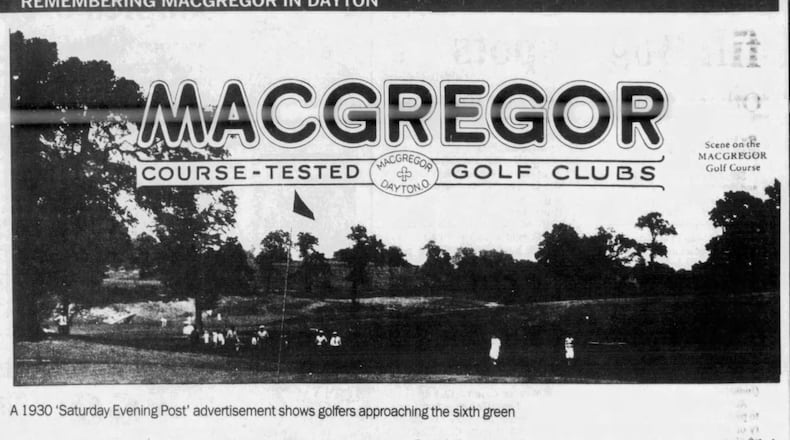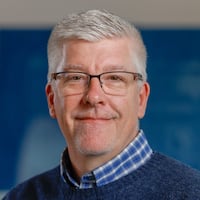In 1829, Archibald and Ziba Crawford, brothers from Saratoga Springs, New York, settled in Dayton and founded the Dayton Last Company, which manufactured the wooden forms over which shoes were shaped and repaired.
The shoe lasts look like wooden feet and were made on a copying lathe so they could be rapidly reproduced.
It was the only company of its kind west of the Allegheny Mountains.
Transition to golf clubs
By 1896, the company was in the hands of W.S. Crawford, a descendant of the original owners, along with partners John McGregor and Edward Canby.
Legend has it that in the late 1800s, while on a business trip to England, Edward Canby asked another manufacturer of shoe lasts for a suggestion on how to keep his workers busy during the down times in business.
The Englishman suggested that Canby’s company produce wooden golf club heads, which at the time were made by hand in England, using beech wood.
Golf was in its infancy in the United States, but Canby liked the idea.
Canby decided to make the club heads out of the same persimmon wood which the company were using to make the shoe lasts. Persimmon is a hard wood from the ebony family and eventually became the most widely used wood in the golf industry.
The company sold their first persimmon club heads in 1896. Three years later the company was shipping 100,000 of them annually to Great Britain.
By the turn of the century CM&C starting making hickory shafts and eventually began to make irons, using a “drop forging” method on the club heads.
By 1912, MacGregor was the premier club brand being manufactured.
In 1922, the company was the first to make a finished golf club with a steel shaft.
The death of Edward Canby resulted in the sale of MacGregor in 1936 to the P. Goldsmith Co. of Cincinnati.
The ‘MacGregor’ name
The first clubs produced were sold under the company name and that of Willie Dunn, the first professional golfer hired to promote them.
After a year though, Dunn quit CM&C and the company started naming their golf products MacGregor.
MacGregor was used because it was John McGregor who introduced Crawford and Canby to the sport. Nobody knows for sure why MacGregor was spelled with an “a,” but there is a theory that MacGregor was chosen because it is the version of the name that is used in Scotland, the birthplace of golf.
Another theory is that the name was accidentally misspelled on the patent application, but the company decided to just go with it because the Scottish implication would give the products more credibility.
Their own golf course
Built in 1916 by and for the Crawford, McGregor & Canby Co. employees, the MacGregor golf course was believed to be the first company-owned course in the United States.
At the time, it was one of the few golf courses in the Dayton area.
Credit: DAYTON DAILY NEWS ARCHIVE
Credit: DAYTON DAILY NEWS ARCHIVE
The company golf course sat on a 126-acre site was on Woodman Drive. The course had nine holes and was primarily for the employees who made the clubs. The owners felt it would be beneficial to have the employees test their workmanship while enjoying themselves.
It was also used as a marketing tool to allow golfers to test MacGregor golf clubs.
MacGregor Park became the Headquarters for AES Ohio (then Dayton Power & Light) in 1988.
Sponsored players
The company that began by hiring Willie Dunn to market their clubs moved on to several other pros, including Willie Hoare and John Harrison before hiring their most famous golfer, Tommy Armour.
Armour, who had won the British Open, U.S. Open and PGA Championships, was hired away from business rival Spalding and in 1936 was made chairman of CM&C’s advisory staff.
Jack Nicklaus joined MacGregor in 1961. In 1962, he won the US Open and two other tour events using MacGregor clubs.
Nicklaus and partner Clark Johnson went on to own the company for a period of time, purchasing it from Wickes Companies in 1982. Nicklaus sold the last part of his stake in 1990.
Legacy
The brand was a powerhouse, with sponsored players winning 59 majors with PGA, U.S. Open, British Open and Masters champions such as Byron Nelson, Ben Hogan, Jack Nicklaus, Johnny Miller, Curtis Strange and Greg Norman.
The headquarters and manufacturing of MacGregor golf products have moved many times and has had many different owners, but the MacGregor brand is still around. It is now considered a value brand and marketed towards beginners.
About the Author









